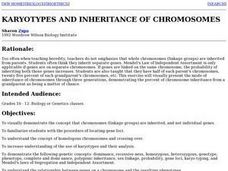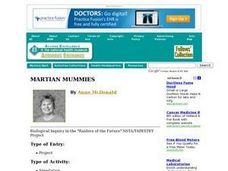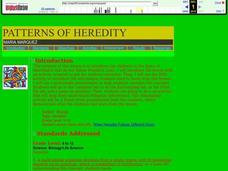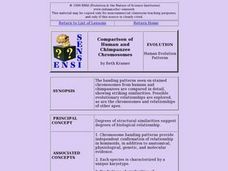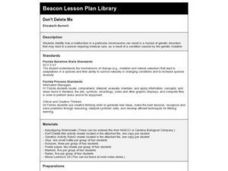Biology Junction
Chromosomes and Karyotypes
One in 150 babies born presents a chromosomal condition, and society is getting closer to recognizing these as normal variations. Scholars learn about chromosomes and karyotypes with a resource that focuses on Down Syndrome as well...
Curated OER
Chromosome Karyotyping
Students explore chromosome karyotyping. In this chromosome karyotyping lesson plan, students use a chromosome kit to explore chromosome syndromes and disorders. They also produce a large model of a cell with chromosome to simulate cell...
Curated OER
The Human Genotype
Six different chromosome activites introduce biology aces to heredity, chromosomal abnormalities, sex-linked traits, and the human genome. The hands-on activites are fairly simple for the teacher to prepare and will prove to be both...
Curated OER
Lesson 10: Karyotypes
Students predict traits of future offspring. In this biology instructional activity, students study karyotyping to predict genetic disorders. They research an assigned karyotype and present information about it.
Curated OER
What is the purpose of Karyotyping?
Students explain how karyotyping is used to diagnose specific genetic disorders. They use karyotypes to make observations and analyze chromosomal errors. This activity can be completed online or without computer access.
Curated OER
Human Heredity Vocabulary
Ninth graders review the terms "aneuploidy," "fetus," and "karyotype" in this vocabulary worksheet, which includes three multiple choice questions about each term. This activity could be expanded into a more developed vocabulary lesson...
Curated OER
Karyotypes and Inheritance of Chromosomes
Students explore the mode of inheritance of chromosomes. Given a scenario, students use the Human Genome sheet to determine inherited chromosomes. They illustrate the difference between genotype and phenotype. Students develop a model...
Curated OER
Genetic Variation Worksheet
Fill- in-the-blank, labeling, and short answer questions make up this well-written cell division worksheet. Neat diagrams of chromosomes and dividing cells are included. Junior biologists show what they know about reproduction, meiosis,...
Curated OER
Raven Chapter 11 Guided Notes: How Cells Divide
Take your advanced biology learners across the great divide: where cells divide, that is! Although it was created as a chapter reading guide, having your class complete this instructional activity is not only appropriate, but also highly...
Virginia Department of Education
Genetic Variation and Mutations
Young scientists demonstrate their creativity while completing several activities, to assess genetic variations and mutations. Instructors provide a list of options and scientists choose to write a comic strip, create a book,...
Curated OER
Jurassic Park: The Science and Ethics of Genetic Engineering
Explore genetic engineering through an engaging "Jurassic Park" unit, which is an extensive use of a cross-curricular teaching event. Planned for AP Biology, English, and Calculus students, learners and teachers are involved for 4-6...
Curated OER
Karyotypes & Chromosome Inheritance
Young scholars study Mendelian genetic terms, locate and name loci on chromosomes, karyotype construction, inheritance patterns through families.
Curated OER
Modeling Allele Distribution Through Meiosis and Fertilization
The main objective of this activity is to illustrate the variation that results from crossing-over during prophase I of meiosis. Other sources of variation from generation to generation are: (1) independent assortment (223 possible...
Curated OER
Martian Mummies
Students participate in "Raiders of the Future", a role play about futuristic scientists sending a spaceship to Mars for research and exploration. They collect geological samples for analysis, discover the ruins of an ancient...
Curated OER
Who's the Father?
Learners analyze gels to determine parentage in this lesson about scientific evidence, investigation, and DNA concepts. The lesson includes a pre-activity worksheet, a final individual assessment, and student handouts for in-class...
Curated OER
Chapter Fourteen Questions: Human Genome
This multiple-choice and short-answer quiz covers chromosomes, genetic disorders, and more. The multiple choice section could work as a pretest, as well.
Curated OER
How Can You Predict the Characteristics of an Unborn Baby?
Learners compare three sets of unlabeled human chromosomes and gather related data, trace chromosomes to pair them, and make observations about them.
Curated OER
Genetic Disorders
Students examine how living cells create new cells and how genetic mutations can cause disorders and be inherited. In this genetic reproductionn lesson students create their own PowerPoint presentation.
Curated OER
Patterns of Heredity
Students describe the differences between incomplete dominance and codominant alleles, and between multiple alleles and polygenic inheritance. They describe how internal and external environments affect gene expression. They then...
Curated OER
Genetics 5 Technology
High schoolers, after studying extraction and gel electrophoresis, recombinant DNA, transgenic organisms, and reproductive cloning, summarize the main concepts in DNA technology. They analyze the applications of DNA: forensics, medicine,...
Curated OER
Comparison of Human and Chimpanzee Chromosomes
Students actively engage in the careful analysis of chromosome banding patterns and identify examples of inversion in homologous chromosomes.
Curated OER
Don't Delete Me
Fourth graders explore genetic disorders, which can be caused by a malfunction in a particular chromosome and how these can cause genetic mutation.
Curated OER
Genetics 4 Mutations
Students identify and illustrate how changes in DNA cause mutations and evaluate the significance of these changes. They illustrate a chromosomal mutation such as duplication, deletion, inversion, and translocation.
Curated OER
The Chromosome Connection
Young scholars evaluate the degree of chromosome similarity and difference between humans and apes. Students infer about the relationship between a human and ape based on similarities found.








